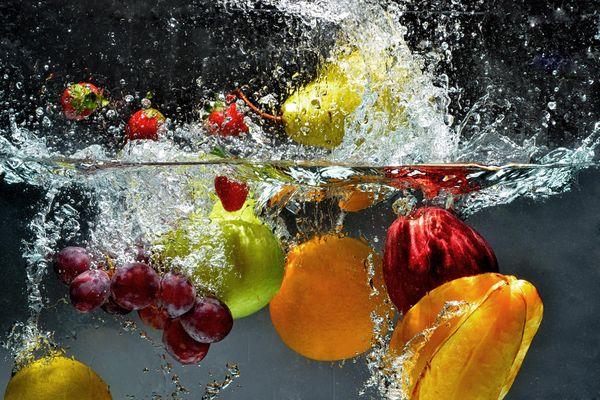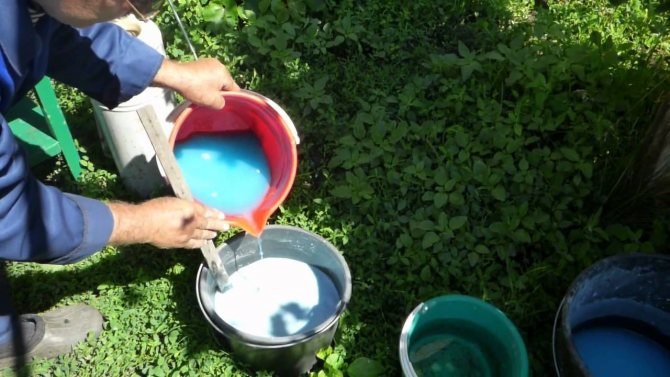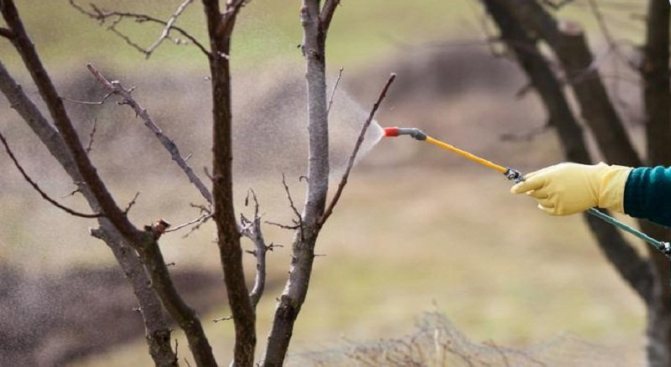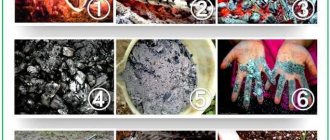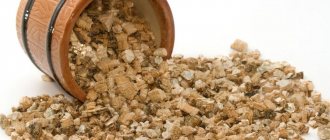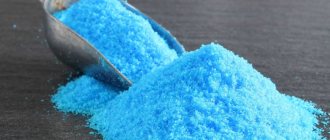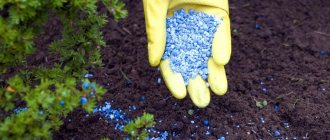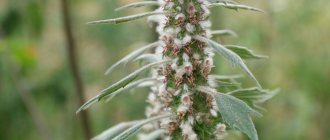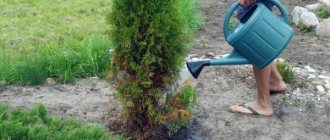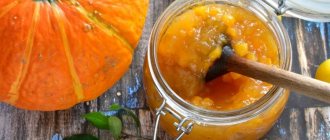Bordeaux liquid is a mixture of copper sulfate, which is better known as copper sulfate, and lime diluted with water. All components are taken in certain proportions that cannot be violated. The resulting preparation is used for spraying many plants, including currants. The tool provides the bushes with protection against fungal pathologies. The drug prevents the occurrence of scab, phytophthora, rot and other similar diseases. However, Bordeaux liquid is a potent poisonous substance. For this reason, the product should be used with caution, strictly following the rules of use.
About the sprayer
The point here is that atmospheric air is pumped into the tank with the working substance. Under the influence of oxygen from it, the nanoparticles of the suspension very quickly aggregate (stick together) into larger lumps, which wear out the sprayer. Therefore, it is necessary to process plants with Bordeaux liquid from a gas sprayer, where the pressure in the tank is created by carbon dioxide. By the way, it also increases the effectiveness of literally all liquid agricultural chemicals due to the absence of the same oxygen under pressure.
A gas sprayer can also be made with your own hands from a plastic tank with a sealed lid for 1.5-2 bar overpressure (PE wall thickness - from 2 mm) and a fitting for a household carbon dioxide cartridge. Such cartridges are used to saturate soda in siphons, and in ship and aircraft modeling - to drive micropneumatic motors. The fitting itself is a steel conical hollow needle (the cone is very shallow) and a holder for a cylinder with a threaded plunger cap. When the cap is screwed on, the cylinder is pierced with a soft alloy stopper on the needle, the gas flows from the tank - that's all.
Note: a more powerful sprayer for a larger area can be operated from a carbon dioxide fire extinguisher for 0.5-2 kg of solid carbon dioxide (dry ice).
Application in horticulture
Spraying of plants is carried out in early spring. After drying, the branches take on a noticeable blue tint. The treatment should be done before the buds open. While they are in the state of the so-called green cone, they can be sprayed with a solution of a stronger concentration - up to 4 percent. Pome crops are treated against scab, stone fruit against coccomycosis and moniliosis, grapes - from mildew and black rot, peach - from curly leaves. Shrubs and strawberries - for leaf spot.

But not only in early spring, Bordeaux liquid is used. The instruction says that it can be sprayed with plants in summer. At this time, the leaves and young stems have already formed sufficiently, and a 1% solution will not damage them, but will destroy pathogens. The latter include:
- scab;
- clusterospirosis, coccomycosis - up to four sprays;
- gooseberry anthracnose - up to three treatments;
- leaf spot (raspberry and strawberry) - two sprays.
Usually, the first treatment of the plant occurs before flowering, the next - after about two weeks, depending on the situation.
Crops are treated with Bordeaux liquid:
- winter crops from snow mold, root rot;
- potatoes, tomatoes for late blight;
- melons, watermelons, cucumbers from anthracnose;
- beets;
- rot onions.
Flowers and shrubs are saved from fungal diseases by processing them before they bloom, and repeating the procedure later.
This drug does not help control pests. To do this, you need to apply insecticides. Bordeaux liquid is prepared from Bordeaux mixture, which also includes lime.
Garden treatment with Bordeaux mixture
We have already written about. And today we will tell you more about the Bordeaux mixture. So, summer residents often ask: Why treat the garden with Bordeaux mixture?
Processing a spring garden with Bordeaux is the main protective measure against fungal diseases. Often pome and stone fruit crops are affected by scab, coccomycosis, moniliosis and other fungal diseases. To protect apple trees, pears, cherries, cherries, gardeners carry out blue spraying in early spring with a 3% Bordeaux solution.
When to spray with Bordeaux liquid
It is necessary to spray the garden with 3% Bordeaux liquid before bud break. The exact dates will depend on the weather conditions. The sooner the snow melts and the warm weather sets in, the earlier the garden processing time will shift.
Re-treatment with 1% Bordeaux liquid is carried out in the garden when buds appear on the trees.
Bordeaux garden processing rules:
- do not spray in windy weather,
- do not process Bordeaux in wet weather,
- in gardens where trees are not resistant to fungal diseases, the treatment with copper preparations should be regular,
- spraying with Bordeaux must be carried out in a protective suit, glasses and a respirator.
How to prepare Bordeaux mixture
Bordeaux mixture is a powder for preparing a working solution. Bordeaux mixture consists of 2 preparations: lime and copper sulfate.
Usually Bordeaux mixture is sold in stores in boxes with instructions for preparing the solution.
How to prepare a 3% Bordeaux liquid solution
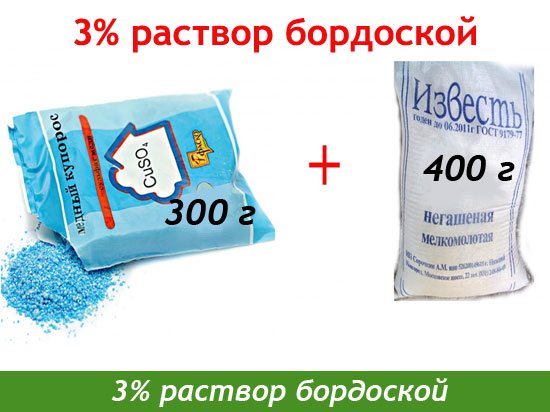

For a 3% Bordeaux solution, you need to take 300 g of copper sulfate and 400 g of lime. In separate plastic containers, vitriol is diluted in 1 liter of water and lime in 9 liters. As soon as the crystals of copper sulfate dissolve, you need to pour a blue solution of copper into the milk of lime (dissolved lime) in a thin stream.
Remember: you need to pour copper sulfate into the lime solution, and not vice versa!
With a solution of Bordeaux 3% concentration, trees must be treated before bud break!
How to prepare 1% Bordeaux liquid solution
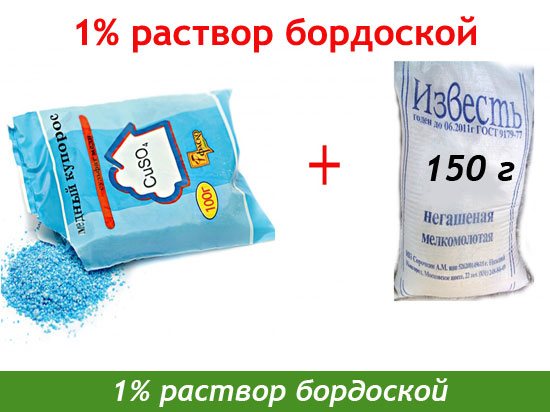

To prepare a 1% Bordeaux solution, you need to take 100 g of copper sulfate and 150 g of lime per 10 liters of water. Copper sulfate is dissolved in a separate container and then poured into the milk of lime in a thin stream.
Treatment with 1% Bordeaux solution is carried out during the growing season of plants.
Protecting plants from diseases with Bordeaux liquid
When processing plants, copper in a solution of Bordeaux liquid is a poison for fungal diseases, and lime is a neutralizer to remove the burn effect of acid on the plant.
Table 2 provides a list of crops and diseases. The main phases of the treatment with Bordeaux liquid are described. A more detailed description of diseases and protection measures can be found on the corresponding sites.
Table 2. Protection of horticultural and vegetable crops from diseases using Bordeaux liquid
| Culture groups | Diseases | Processing period |
| Perennial fruit crops | ||
| Pome fruits: pears, apple trees, quince | Fruit rot, leaf rust, scab, phyllostictosis, moniliosis, black cancer, powdery mildew, leaf spots. | Before the beginning of the spring growing season and after the leaves have completely fallen off, the plants are treated with a 3% solution of Bordeaux liquid. During the growing season: in the bud extension phase and after flowering, spray with a 1% solution of Bordeaux liquid. The rest of the time - as needed. Stop processing 2 weeks before harvesting. |
| Stone fruits: cherries, cherries, plums, cherry plums, peaches, apricots | Coccomycosis, leaf curl, moniliosis, clasterosporiasis. | Before the beginning of the spring growing season and after the leaves have completely fallen off, the plants are treated with a 3% solution of Bordeaux liquid. From the budding phase to the beginning of flowering and in the phase of the onset of ovary growth, they switch to spraying with a 1% solution of Bordeaux liquid. Apricots and cherries are highly sensitive to Bordeaux liquid (deformation and cracking of the fruit is observed). It is better to treat them with a 0.5% solution of Bordeaux liquid. Stop processing 2 weeks before harvesting. For more details, see the article "Summer diseases of berries and fruit crops" |
| Berry crops | ||
| Grapes | Mildew (downy mildew), anthracnose, black rot, rubella, cercosporosis, melanosis. | The bushes are treated with Bordeaux liquid in the phase of leaf deployment and during the growing season 1 time in 2-3 weeks for the purpose of prevention and from other concomitant infections. For more details, see the article "Protection of grapes from fungal diseases" |
| Gooseberries, raspberries, currants, blackberries, wild strawberries and strawberries | Leaf spot, leaf rust, anthracnose, septoria, black rot. | Berry growers have a shorter growing season, therefore, during the season, 2-3 treatments are carried out with a 1% solution of Bordeaux liquid before bud break and before flowering begins. The third treatment is carried out mainly after harvesting. For more details see the article |
| Main garden crops | ||
| Cucumbers, zucchini, pumpkins, beans, tomatoes, cabbage, onions, garlic, peppers, eggplants, potatoes | True and downy mildew, root and root rot of seedlings and adult plants, fusarium wilting, anthracnose, late blight. | For the first time, seedless vegetable crops are sprayed with Bordeaux liquid in order to prevent fungal diseases in the phase of mass germination. The second spraying is carried out with the deployment of 2 - 3 true leaves. On seedlings, the first spraying with Bordeaux liquid is carried out 2 weeks after planting. For the treatment of plants, a 0.5-1% solution of Bordeaux liquid is used. In the subsequent growing season, spraying with Bordeaux liquid is carried out according to the recommendations and at the first manifestations of the disease. |
Be careful!
- Large drops of Bordeaux liquid are phytotoxic to plants, especially during the growing season.
- The Bordeaux liquid solution flowing down from the leaves to the soil contributes to the accumulation of copper in it, which negatively affects the crops grown (causes the leaves and ovaries to fall off).
- Repeated use of Bordeaux liquid without observing the recommended processing times for plants during the growing season can cause their death.
- It makes no sense to add soap to Bordeaux liquid. From its addition, contact with plants will only decrease.
- Bordeaux liquid is incompatible in tank mixtures with other drugs. Colloidal sulfur is an exception.
How to properly prepare a solution of a copper-containing drug - Bordeaux liquid
Bordeaux liquid is a fungicide, when properly prepared, copper sulfate is formed, which has a neutralizing effect on all harmful microorganisms. Treatment of plants with this drug is still in high demand among gardeners, as it is a simple and proven remedy. This fungicide is used to prepare many solutions that treat wounds on trees after cutting the crown, and also add to whitewash. Bordeaux liquid serves not only as a means of combating diseases and insects, but also is a good preventive measure that helps prevent the development of many diseases.
Most often, amateur gardeners prepare a 1% solution of Bordeaux mixture, although in some cases a 3% solution of the drug is also needed.
To obtain a 1% solution of Bordeaux liquid, you will need 10 liters of water and 100 grams of fresh lime and copper sulfate each. The proposed amount of copper sulfate should be dissolved in 1 liter of water using dishes made of wood, glass or plastic. It is worth abandoning the use of iron containers, since their chemical reaction with the solution will occur, and it will lose its useful properties. In order for the copper sulfate to completely dissolve, it is recommended to thoroughly stir the prepared solution.
The same procedure is done with slaked lime, that is, 100 grams of the substance is thoroughly mixed in 1 liter of water to the consistency of thick milk without lumps. In the process of preparing both solutions, upon reaching the desired consistency, each of them is topped up with water, and their volume is brought to 5 liters each.
The resulting liquids should be mixed among themselves, having previously filtered each of them through cheesecloth or burlap. A solution of copper sulfate is added to the lime mixture, thoroughly stirring the resulting Bordeaux mixture of light blue color.
Mixing of two solutions of high concentration with subsequent dilution with water is not allowed, and a different sequence of preparation of Bordeaux liquid is not allowed, when slaked lime, on the contrary, is poured into a container with copper sulfate.
If it is necessary to use a solution of high concentration, they resort to preparing a 3% mixture, while the recipe adheres to some changes. In order to obtain a 3% liquid solution, 300 grams of copper sulfate and 300-400 grams of slaked lime are used. Further technology for the preparation of a 3% solution is no different from the preparation of 1%.
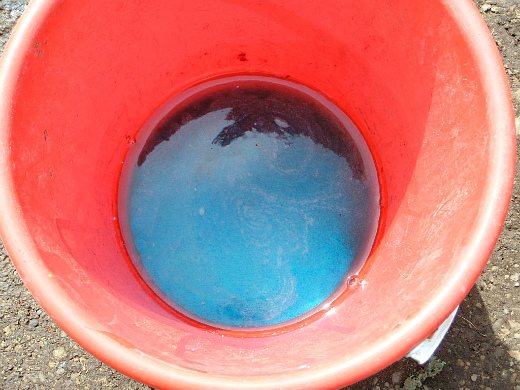

Bordeaux liquid, prepared taking into account all the rules and recommendations, acquires a neutral or slightly alkaline reaction, which can be checked using available means. You can use a conventional acid indicator, on which a small amount of the drug is applied and its reaction is determined. In the absence of such a device, you can use an ordinary iron object on which there are no traces of rust, for example, a wire or a nail. The selected item is placed in the prepared Bordeaux mixture for a few minutes, after which it is carefully examined. The formation of reddish-red spots on the subject indicates a violation of the preparation process and the formation of a solution of high acidity. A solution of this concentration can have a negative effect on the treated plants, cause their death or leave burns. The addition of milk of lime to the solution will help to correct the situation, which will lead to a decrease in acidity. In a Bordeaux liquid prepared without violating the technology, an iron object immersed in it should not be covered with lime.
It is advisable to use the prepared mixture for processing plants on the day of its preparation, and to preserve its beneficial properties during the day, it is recommended to add a little sugar to it.
Precautions
Determining the alkaline reaction with a nail will help prevent burns on plants. If copper spots appear on it, then the solution is too strong and must be diluted with a small amount of hydrated lime. The fungicidal properties of such a liquid will be minimal and, if excessively adhering to crops, it will provoke burns.
Due to the high toxicity of the Bordeaux mixture during the period of work, you need to stop smoking and eating. Protective gloves and a respirator must be worn. After spraying, you need to change clothes and wash your hands and face thoroughly. If there are signs of poisoning (nausea, dizziness, pain in the eyes), it is recommended to take 6-8 tablets of activated carbon and consult a doctor.
How to cook it yourself
Such a drug can be bought and it will be easier.But you can also make a fungicide on your own. So, its main active ingredients are lime (of course, quicklime) plus copper sulfate. They are bred separately
Pay special attention to the container in which you will prepare the mixture and its components. Since copper enters into active reactions with various metals, it is impossible to use containers made of iron, galvanized or aluminum.
Look for buckets made of glass, plastic, or enamel (but not chipped or damaged). For lime, it is better to take a larger container, preferably ten-liter.


To obtain a one percent solution, we take 10 liters of water, 100 g of vitriol itself and 150 g of lime. For a solution of three percent vitriol, 300 g are needed, water - all the same 10 l, and lime - 100 g more than vitriol.
The Bordeaux mixture is prepared as follows:
- Pour copper sulfate powder with hot water, stir well. Add cold water to the solution so that we get five liters. Cool the mixture;
- We make lime milk with five liters of cold water;
- Now pour the dissolved vitriol into this milk in a thin stream (just not vice versa);
- Checking the reaction. For this, both a litmus test and just a piece of wire or even a nail are suitable. A reddish coating on the nail will indicate the critical amount of copper in the mixture. Such a spray agent is in no way suitable, as it can burn the leaf plates. Add more lime solution.
Pay attention to the quality of the components. Old lime is not very suitable for us. In addition, heat is actively generated during the dissolution of quicklime. If it does not stand out, or a lot of sediment appears, this is not very high-quality lime, buy a fresher and better one. You can also simply increase its dosage.
Mechanism of action
Proteins have so-called sulfhydryl and amino groups.
A sulfhydryl group is a sulfur atom with a hydrogen atom attached to it. Such a group is found, in particular, in the cysteine amino acid molecule. The sulfhydryl group plays a role in maintaining the tertiary structure of the protein - in other words, thanks to this group, the molecule has a certain geometric shape (and can perform a certain function).
An amino group is a nitrogen atom with two hydrogen atoms. It is found in all amnioacids and has a lot to do with protein function.
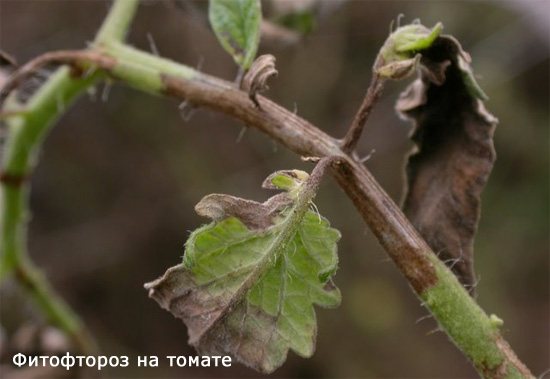

The active substance of the Bordeaux mixture is copper ions from copper sulfate. They bind to sulfhybrile and amine groups, which leads to disruption of normal functioning and partial destruction of the protein. This, in turn, disrupts the normal functioning of the membranes of fungal cells (not only, but for a number of reasons, copper acts especially effectively on fungi and precisely on membranes), and they stop developing or completely die.
Instructions for using the drug
The instructions for use of the Bordeaux mixture indicate that it cannot be mixed with other agents and used simultaneously with other fungicides.
Trees are treated with the drug in spring and autumn.
In the spring, prophylactic spraying is carried out. It is allowed to use a solution of 3% concentration when the buds are swollen or have just begun to bloom. If the tree already has leaves, a 1% solution should be used.
In autumn, processing is carried out only with a 3% solution. This is because the foliage is already fallen and there is no risk of burns. The use of Bordeaux liquid in gardening in autumn will help protect fruit trees from fungi: pear, cherry, apple, plum, quince, apricot.
Bordeaux liquid is widely used for the following crops:
- Tomatoes. If the seedlings show signs of disease (black spots on the foliage), it is necessary to spray it with a 1% solution using a spray bottle.Primary processing is carried out two weeks after planting seedlings in open ground. This is necessary to prevent the manifestation of late blight. 10 sq. m of the site will require at least 2 liters of solution. The procedure is performed three times a season, every 2 weeks.
- Cucumbers. The processing process is the same as for tomatoes (solution of 1% concentration; consumption - 2 liters per 10 square meters. M). The first spraying is carried out when the third leaf appears. Subsequent treatments should be carried out every 15 days, three times a season. The last treatment is carried out no later than 3 weeks before the first harvest.
- Berry bushes. Currants are sprayed to prevent spotting. Primary treatment is carried out in early spring, with a 3% solution of Bordeaux liquid. Then they are processed 3 more times per season, but already with 1% composition. Raspberries, gooseberries and grapes are sprayed in the same way.
- Roses are treated to combat black spot. A characteristic feature of the disease is the appearance of many dark spots on the leaves. They grow rapidly, causing dropping. Spores of pathogenic microorganisms can spread to healthy bushes. The causative agents of the disease are resistant to low temperatures. If a rose was infected with an infection last season, after wintering, the disease does not disappear anywhere. If spots appear in the summer, you need to treat the bushes with a 3% solution every 10 days. Repeat the procedure 4-5 times. Then the roses should be re-treated in the fall to prevent a second wave of infestation. It is necessary to spray the bushes and the soil around them abundantly. Carry out a similar treatment in the spring.
- Strawberry. Initially, processing is carried out after the snow has melted. A 3% solution should be prepared. 10 sq. m will be enough for one liter. During the period of leaf growth, the procedure is repeated, but a less concentrated composition is used. In the flowering phase and immediately after fruiting, spraying with a 1% mixture is carried out.
Security measures
After applying the Bordeaux mixture, the processed fruits are always washed under running water. For long-term storage in sheds and cellars, it is recommended to wash with soap to ensure that the fungicide is washed off.
Since the fungicide is toxic, but the level of toxicity is average, precautions will not harm during cultivation, processing of plants. To do this, use protective suits. Old clothes will do as well. Only the hair, face and hands are necessarily covered.
The following safety rules are:
- do not mix Bordeaux liquid with soap or other fungicides, minerals;
- filter the resulting liquid through thick gauze. Otherwise, the sprayer will clog;
- measures to protect plants in the wind, hot weather, precipitation are not carried out.
Several rules for processing plants with Bordeaux mixture
For processing, a three percent solution is usually used. Sprayed either in October-November or in March, while the buds of the plants have not yet blossomed. In the fall, it is best to spray only bushes with trees.
We use Bordeaux liquid carefully in the spring. During the period when the kidneys pass the stage of green cones, a one percent solution is needed
The same concentration is used during the growing season. Be careful with the product for grapes and all drupes.
To treat one mature tree, it is appropriate to use about ten liters of the product. Two liters of it will be enough for young trees. For a vineyard with an area of ten square meters, one gooseberry or currant bush, you need about one and a half liters of the drug.
We process raspberries with strawberries with a solution of three percent. For a dozen meters of plantations, one and a half liters are needed. We spray it again after picking the berries, but here we need a one percent solution.
Vegetables are also sprayed with a 1% solution. It is best to do this during the growing season. For 10 square meters, you need a liter and a half.It is best to spray on a dry day, early in the morning or after the sun has set. But the intense heat is also not suitable here. The mixture must not fall on the ground. This is fraught with the accumulation of toxins in the soil, which is not good.
Also, be sure to follow a few safety rules:
- Wait for calm weather for spraying. Make sure that there are no animals and people nearby;
- For processing with the mixture (and for its preparation too), special clothing is needed. So, we must spray in a respirator, headdress and gloves;
- It is forbidden to drink, eat and smoke during such work;
- The agent can enter the body through the mouth or nose. If it gets into the gastrointestinal tract, there will be stomach problems, headaches and thirst. With severe intoxication, there will be heart pain, convulsions, and sometimes coma. After inhalation, fever, abdominal pain and distension, chills, fever, nosebleeds and vomiting are observed;
- In case of intoxication, you need to drink abundantly a solution of potassium permanganate or salt, as well as diuretics and diaphoretic. Be sure to call your doctor. You can not drink milk, eat fatty foods and butter;
- An overdose of the agent will be dangerous for the plants themselves. It can lead to cracking of fruits, roots and vegetables, as well as stunted growth of young plants and damage to the leaf plates.
Important! If you have processed the fruits, it is far from immediately possible to collect and eat them. So, you can eat vegetables only after three weeks, fruits - after half a month, berries not earlier than after a month
How to prepare a bordeaux liquid solution
Bordeaux mixture is a two-component preparation: lime powder and copper sulfate powder. Depending on the season, 1% and 3% Bordeaux solutions are used.
In the early spring period (before bud break), a 3% concentration of Bordeaux liquid is used (300 g of copper sulfate and 400 g of lime per 10 liters of water). During the growing season of plants (when leaves have appeared and plants are actively vegetating), a 1% solution is prepared (100 g of copper sulfate and 100-150 g of lime per 10 liters of water)
Lime and copper sulfate are diluted with water in separate containers. You can take plastic buckets, glass or wooden containers.
Do not use metal utensils to prepare the solution!
The working fluid prepared for spraying should be used immediately after preparation.
Remember: we pour the solution of copper sulfate into the milk of lime !!!
Preparation of a 1% solution of Bordeaux liquid. Video
Take 100 g of copper sulfate and dissolve in 1 liter of warm water in a wooden or ceramic dish. When the vitriol is completely dissolved, add another 5 liters of water.
In another container, fluff-lime is dissolved in an amount of 150 g per 5 liters of water, then the resulting solution of copper sulfate is poured into a solution of fluff-lime in a thin stream.
Bordeaux liquid must be filtered before use.
Preparation of a 3% solution of Bordeaux liquid
A 3% solution of Bordeaux liquid is used in the early spring period. Take 300 g of copper sulfate and dissolve in 1 liter of warm water (not higher than 50C). Stir the solution until all crystals are dissolved. Bring the solution to 9 liters with water. In another container, dissolve 400 g of lime in 1 liter of water.
Wait until the solutions reach the same temperature and slowly, in a thin stream, pour the solution of copper sulfate into the milk of lime (If you do the opposite, the solution will be ineffective).
Solution preparation rules
On the shelves of garden stores, you can buy a ready-made concentrated solution that must be diluted with water. It is packaged in bottles (0.5 l) and vials (100 ml). But it's better to make the remedy yourself. Preparing Bordeaux liquid does not take long and does not require special skills. Do not neglect safety measures - you should wear a protective suit, gloves and a respirator.It is necessary to allocate separate containers for the solution, which will not subsequently be used for other needs. The remains of the mixture must be disposed of.
It is necessary to prepare the composition before use. If the work needs to be rescheduled for the next day, add 20 g of sugar to the mixture. So the solution will not lose its properties.
Often, 1 or 3 percent solutions are used. To prepare a 1% mixture you need:
- Take two containers of glass or clay (metal is prohibited). Their volume must be at least 10 liters.
- Dilute 150 g in one liter of water. Add 4 liters of water gradually.
- In another container, mix 100 g of copper sulfate and 2 liters of hot water. After the mixture has cooled, add 3 liters of cold water.
- Mix both compositions well.
- Add copper sulfate to the lime in a thin stream (not vice versa). Stir the resulting Bordeaux mixture solution.
Preparation of a solution of 3% concentration is similar to the previous one. You just need to increase the amount of dry ingredients and take 0.3 kg of copper sulfate and 0.45 kg of lime.
Qualitative characteristic
Bordeaux mixture named that way, thanks to two main components: copper sulfate and quicklime. As a result, a fungicidal substance is released, which is used to destroy garden pests. The preparation contains calcium, which helps many plants to gain strength against fungal diseases.
Under the influence of copper compounds formed as a result of a chemical reaction, fungal spores die. Crystalline copper compounds hang on branches for a long time, prolonging the active reaction of the active substance and preventing fungal spores from growing their colonies. The lime solution regulates the action of the preparation and practically "sticks" the active ingredients to the plant for a long time.
It is better to use Bordeaux mixture separately from other substances. Do not mix the substance with soap and other insecticides. It is better to coordinate the complex use of liquid with other drugs with specialists - agronomists or get detailed advice in a specialized store.


In the spring
Be extremely careful when spraying early in the spring. Grape processing should be carried out no later than April
For spraying apple trees, pay attention to the budding stage: if a green cone is already visible, it is best to use a 1% solution. It is also advisable to use this concentration during the growing season.
The most sensitive are stone fruit trees and grapes.
- An adult tree will need 10 liters of solution, and a young tree will need 2 liters.
- For the prevention of grapes, you will need 1.5 liters of liquid per 10 square meters.
- Shrubs are treated with 2 liters of the drug.
- Berry crops (strawberries, raspberries) are treated with Bordeaux mixture in spring. Dilute 0.5 liters of the drug (3%) into 10 square meters. Subsequent spraying should be done with a weaker solution.
- Vegetable crops (cucumbers, tomatoes) are treated with a 1% solution during the growing season. Up to one and a half liters per 10 square meters.
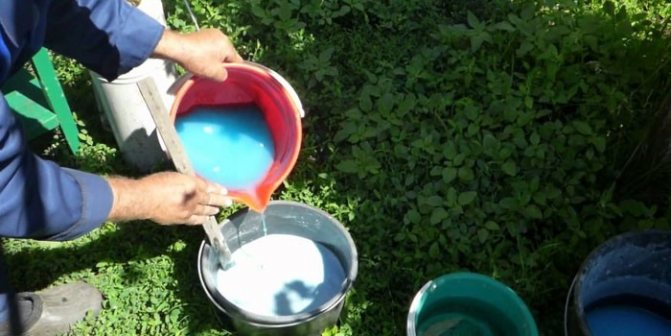

Where to buy seeds and seedlings with delivery


Scientific and production association "Gardens of Russia" has been introducing the latest achievements for 30 years! In the selection of vegetable, fruit, berry and ornamental crops. For general practice of amateur gardening.
The work of the association uses the most modern technologies. A unique laboratory for microclonal reproduction of plants has been created.
The main task of NPO Sady Rossii is to provide gardeners with high-quality planting material. The most popular varieties of various garden plants and novelties of world selection. Delivery of planting material (seeds, bulbs, seedlings) is carried out by Russian post.
We are waiting for you for shopping.
Did you like the article? Share with your friends on social networks:
How to spray trees, berry bushes and vegetable crops
A sprayer is needed to evenly apply Bordeaux liquid to plants. This device allows you to quickly and evenly apply the solution to trunks, branches and foliage. Sprayers are chosen based on the height of the plants, and the amount of work matters.
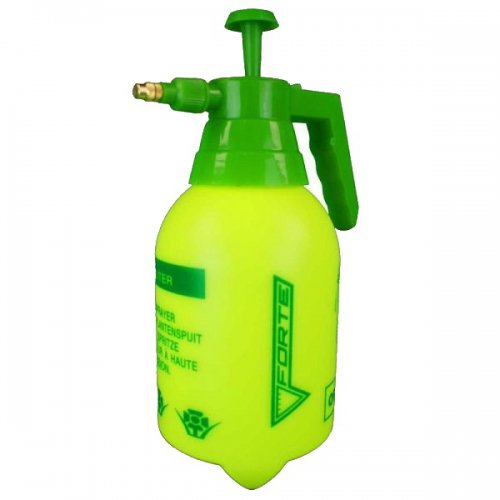

A hand sprayer in the form of a small plastic flask with a spray bottle is used to treat vegetable beds, flower beds, small plantings of potatoes, tomatoes and cabbage with chemicals. If the volume of work is large, you can purchase a pump sprayer, or a sprayer with a manual pump for 7-15 liters. Knapsack sprayers have a cylinder capacity of 10 to 15 liters.
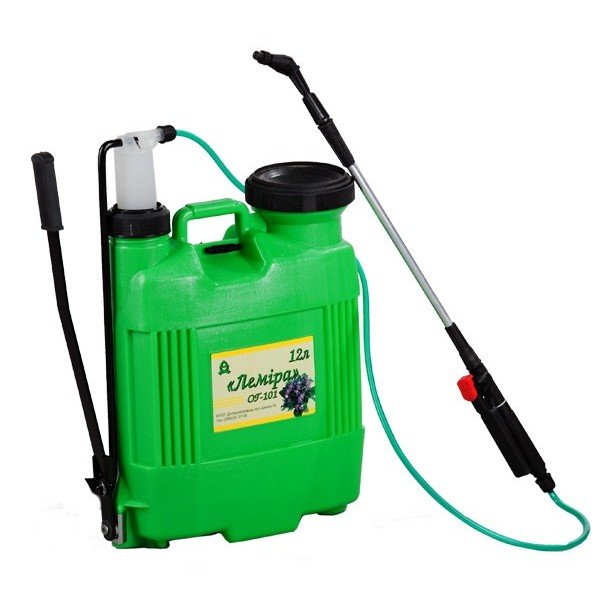

It is not difficult to work with these devices. The pressure in the cylinder is created by several movements of the rod. The flask (container for the solution) must be strong; when buying, it is better to choose devices with translucent containers through which the level of the drug inside is visible.
To treat tall trees, sprayers with long hoses and fishing rods are used, onto which spray nozzles are screwed. The longer the rod, the better the chemical coverage of tall trees and overgrown berry bushes. The nozzle should create a cloud of sprayed liquid that evenly covers all parts of the plant. Spraying the garden and vegetable garden is carried out in the following order.
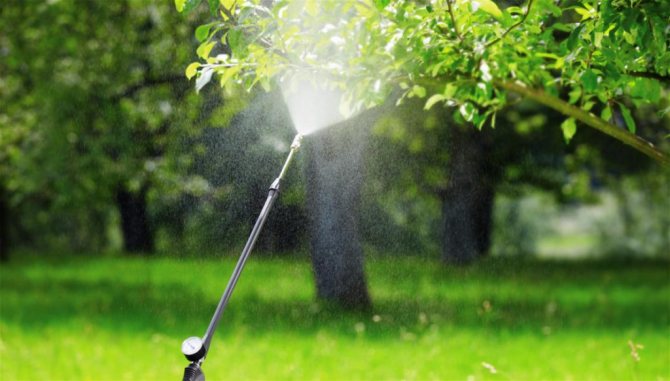

- The gardener puts on a protective suit, respirator, gloves.
- All items that could damage the chemical, animals and children are removed from the garden or vegetable garden.
- The prepared Bordeaux liquid is poured into the sprayer container, the device is assembled according to the instructions and brought into working condition.
- The liquid is evenly sprayed onto the plants. It is impossible to "pass" the sprayer several times in one place.
- It is not recommended to return to a cultivated garden or vegetable garden within 6 hours.
Garden and vegetable garden processing is not carried out in very dry and hot weather, as copper sulfate can "burn" plants. Spraying chemicals is not done in the rain, with strong dew. The best time to process is morning and evening in the afternoon with moderate temperatures and humidity.
Vegetables and fruits should not be eaten immediately after applying Bordeaux liquid. Fruits can be eaten 2 weeks after spraying the garden, vegetables - after 3 weeks, berries - after 3-3.5 weeks. Before eating, food is thoroughly washed in running water.
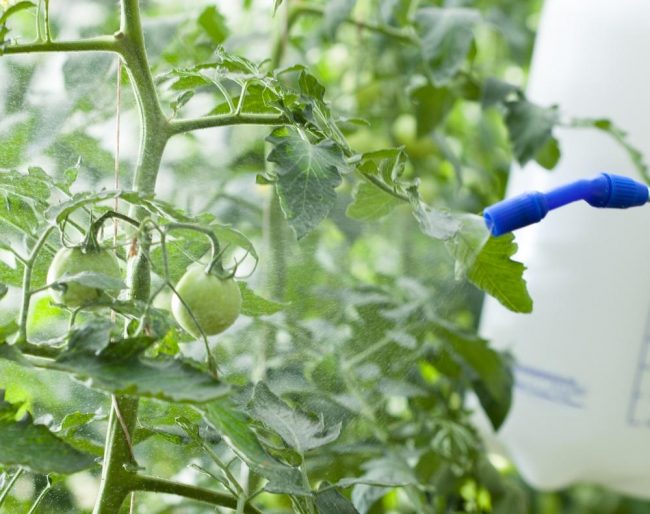

After spraying the plants, Bordeaux liquid protects the plants from fungi for up to 30 days (in dry and moderately humid weather). When processing a garden and vegetable garden, it is necessary to exclude as much as possible the ingress of the chemical on the soil under the plants.
Bordeaux liquid is incompatible with other chemicals that decompose quickly in an alkaline environment. This agent is not mixed with other fungicides in order to avoid chemical reactions. The liquid must not be mixed with soapy water.
How to cultivate the soil
In order to prevent mushrooms from infecting root crops, gardeners process the soil before digging (or immediately after it) with a 1% solution of Bordeaux liquid. In the loosened earth, the agent penetrates deeply into the soil and destroys fungi. For treatment, it is better to use a spray bottle rather than a watering can.
Negative soil changes due to improper use of Bordeaux liquid
When spraying a garden and vegetable garden with preparations containing copper, it must be borne in mind that this chemical element quickly accumulates in the soil and is very slowly washed out of it. Excess copper leads to the fact that the leaves of plants become brownish, brown, yellow veins appear on them. Plants grow slowly and poorly absorb iron from the soil. Many lateral branches are formed on their roots. On a site that has been treated with copper sulfate for decades, it is impossible to get good yields, and some crops die in such conditions.Therefore, you should not get carried away with the processing of Bordeaux liquid.
Bordeaux liquid is considered one of the most effective means of combating fungal diseases in the garden. In order not to harm plants and soil, processing should be carried out strictly according to the instructions from the drug manufacturers.
Harm to humans
Bordeaux liquid is a compound that is toxic to the human body. Once in the digestive tract or respiratory organs, it causes severe intoxication, accompanied by irreversible depression of the internal systems. Without timely medical assistance, a person dies.
It is categorically impossible to eat vegetables and fruits recently treated with Bordeaux solution. Plant products are suitable for food only after at least 3 weeks after chemical exposure.
Before use, vegetables and fruits must be thoroughly washed, and it is better to soak in water for several hours.
